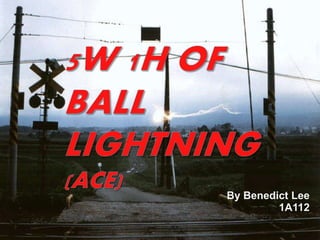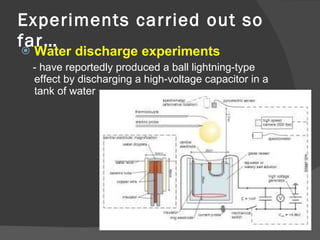Ball Lightning (ace)
- 1. By Benedict Lee 1A112
- 2. WHAT : Introduction Ball Lightning is… Atmospheric electrical phenomenon Spherical object which varies from the size of a pea to several meters Usually associated with thunderstorms Extremely rare and unpredictable Lasts for very long
- 3. Disclaimer! This is a SIMPLIFIED review of the available literature published in 1972 which identified the properties of a “typical” lightning ball, whilst cautioning against over-reliance on eye-witness accounts.
- 4. Characteristics Appear simultaneously with cloud-to-ground lightning discharge Generally spherical or pear-shaped with fuzzy edges Diameters range from 1-100 cm, most commonly 10-20 cm Brightness of a domestic lamp Can be seen clearly in daylight
- 5. Characteristics A wide range of colours has been observed, red , orange and yellow being the most common 1 second to over a minute Brightness remains fairly constant Tend to move horizontally, vertically, remain stationary or wander erratically at a few meters per second
- 6. Characteristics Many described as having rotational motion Sensation of heat is observed (sometimes when the ball disappears) Some display an attraction towards metal objects May move along conductors such as wires or metal fences Some appear within buildings passing through closed doors and windows
- 7. Characteristics Some have appeared within metal aircraft and have entered and left without causing damage Disappearance of the ball is generally rapid and may be either silent or explosive Odours resembling ozone , burning sulfur , or nitrogen oxides are often reported
- 8. WHY/HOW : Vaporized silicon hypothesis Suggests that ball lightning consists of vaporized silicon burning through oxidation. Lightning striking Earth's soil could vaporize the silica contained within it, turning it into pure silicon vapour. As it cools, the silicon could condense into a floating aerosol, bound by its charge, glowing due to the heat of silicon recombining with oxygen. An experimental investigation of this effect, published in 2007, reported producing "luminous balls with lifetime in the order of seconds" by evaporating pure silicon with an electric arc. Possible scientific explanations
- 9. WHY/HOW : Nanobattery hypothesis Oleg Meshcheryakov suggests that ball lightning is made of composite nano or submicrometre particles, each particle constituting a battery. A surface discharge shorts these batteries, resulting in a current which forms the ball. His model is described as an aerosol, but not aerogel model that explains all the observable properties and processes of ball lightning. Possible scientific explanations
- 10. WHY/HOW : Black hole hypothesis Another hypothesis is that some ball lightning is the passage of microscopic primordial black holes through the Earth's atmosphere as proposed by Mario Rabinowitz in Astrophysics and Space Science journal in 1999. Inspired by M. Fitzgerald’s account of ball lightning on 6 August 1868, in Ireland that lasted 20 minutes and left a 6 meter square hole, a 90 meter long trench, a second trench 25 meters long, and a small cave in the peat bog, Pace VanDevender, a plasma physicist at Sandia National Laboratories in Albuquerque, New Mexico, and his team found depressions consistent with Fitzgerald’s report and inferred that the evidence is inconsistent with thermal (chemical or nuclear) and electrostatic effects. Possible scientific explanations
- 11. Black Hole Hypothesis continued … An electromagnetically levitated, compact mass of over 20,000 kg would produce the reported effects but requires a density of more than 2000 times the density of gold, which implies a miniature black hole. He and his team found a second event in the peat-bog witness plate from 1982 and are currently trying to geolocate electromagnetic emission consistent with the hypothesis. His colleagues at the institute agreed that, implausible though the hypothesis seemed, it was worthy of their attention. Possible scientific explanations
- 12. Experiments carried out so far… Water discharge experiments - have reportedly produced a ball lightning-type effect by discharging a high-voltage capacitor in a tank of water
- 13. Experiments carried out so far… Home microwave oven experiments - involve using a microwave oven to produce small rising glowing balls, often referred to as "plasma balls".
- 14. Experiments carried out so far… Silicon experiments - involved shocking silicon wafers with electricity
- 15. WHO : Witnesses In a 1960 study, 5% of the US population reported having witnessed ball lightning. Another study analyzed reports of 10,000Â cases.
- 16. Witnesses’ Quotes “ Five men were knocked down and one of them much bruised. Just before the explosion, the ball seemed to be the size of a large mill-stone.” “ The ball left a red spot on Richmann's forehead, his shoes were blown open, and his clothing was singed. His engraver was knocked unconscious. The door frame of the room was split and the door was torn from its hinges.” “ three "balls of fire" appeared and "attacked" the British ship HMS Warren Hastings.”
- 17. Witnesses’ Quotes “ the balls sometimes split into smaller balls and may explode "like a cannon". ” “ As I looked at it, it exploded with a sharp report quite impossible to confuse with the continuous turmoil of the lightning, thunder and hail, or that of the lashed water and smashed wood which was creating a pandemonium outside the cottage. I felt a very slight shock in the middle of my right hand, which was closer to the globe than any other part of my body.””
- 18. WHERE/WHEN : Occurrences The Great Thunderstorm of Widecombe-in-the-Moor The Catherine and Mary The Montague Georg Richmann HMS Warren Hastings Tsar Nicholas II Aleister Crowley
- 19. Photograph of ball lightning Ball lightning Credits: Miyuki Ishikawa in http://parasearcher.blogspot.com/2009/08/lights-in-sky-ball-lightning.html
- 20. Credits http://parasearcher.blogspot.com/2009/08/lights-in-sky-ball-lightning.html http://www.unexplained-mysteries.com/column.php?id=129287 http://news.nationalgeographic.com/news/2006/05/060531-ball-lightning.html http://amasci.com/weird/unusual/bl.html http://skeptoid.com/episode.php?id=4192#bottom http://en.wikipedia.org/wiki/Ball_lightning http://www.eetimes.com/electronics-news/4069215/Ball-lightning-explained- ball-lightning[1].jpg




















![Credits http://parasearcher.blogspot.com/2009/08/lights-in-sky-ball-lightning.html http://www.unexplained-mysteries.com/column.php?id=129287 http://news.nationalgeographic.com/news/2006/05/060531-ball-lightning.html http://amasci.com/weird/unusual/bl.html http://skeptoid.com/episode.php?id=4192#bottom http://en.wikipedia.org/wiki/Ball_lightning http://www.eetimes.com/electronics-news/4069215/Ball-lightning-explained- ball-lightning[1].jpg](https://image.slidesharecdn.com/balllightningace-100915094100-phpapp02/85/Ball-Lightning-ace-20-320.jpg)